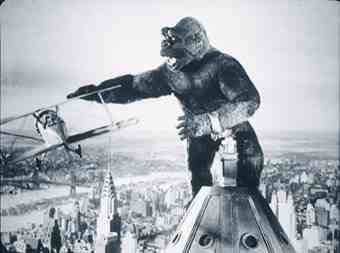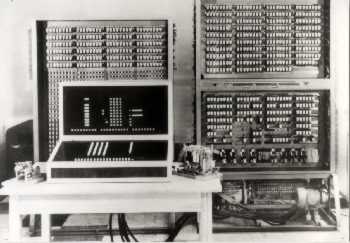| Konrad Zuse and the First Working Computers |
| Written by Historian | ||||
Page 2 of 3
Z2 - The First Relay-Driven ComputerThe next step was to build the Z2. In this Zuse replaced the mechanical switches with electro-mechanical switches - relays. This is the earliest known use of relays in a computer. However the memory remained mechanical and while the Z2 was faster it still wasn't reliable. It used a 16-bit fixed point arithmetic unit and the clock rate was increased to 5 cycles per second, meaning it could perform slightly less than one addition per second. Fortunately one time that it did work perfectly was during a demonstration to Alfred Teichmann, a leading aircraft designer. He was impressed enough to arrange for backing to build a third machine. The Z3 - The First Programmable ComputerThe next task was to build a new machine - the Z3. At the time of the Z3 an important new influence entered the scene - King Kong. Yes, the hairy giant ape that climbed the Empire State building and was shot down by biplanes!
King Kong - an affect on computing history? Zuse was a fan of the film and so were many of his friends, enough to form a fan club. They decided to produce a stage version of the film and Zuse hoped for the part of Kong - but in the end the honour fell to an even larger man - Helmut Schreyer. The play ran for weeks in a Berlin theatre. Night after night Schreyer would lurch about the stage smashing papier mache skyscrapers and being shot by toy planes. What has this got to do with computing? The answer is that Schreyer was an engineer and he and Zuse talked endlessly about computers during the rehearsals. Schreyer suggested that Zuse used valves as the switching element in the logic gates. The fact the Zuse's machine was based on logic gates implied that you could build it using any technology suitable for implementing logic gates. Valves were fast switches but they were expensive and with the limited backing that Zuse had they were well beyond his reach. However the pair did realise that a valve computer was a possibility and so saw the future while playing King Kong. Schreyer used the ideas in his doctoral thesis in 1938 even though Zuse had to return to relays for the Z3. When the war started in 1939 Zuse was drafted into the German army. As a leading specialist developing machines vital to the war effort? No as a simple soldier. However after six months it was realized that he could do more for the war effort as an engineer. But rather than appointing him to design and build computers for the Nazi regime, he was discharged from the army. Hitler himself took no interest in computers and saw them as irrelevant to a war he assumed would be over in a matter of months. So when in 1940 Zuse and Schreyer proposed a high-speed computer using vacuum tubes specifically for cracking code they were asked if it would take more than a year to build. When they admitted that, yes, it would take more than a year, the authorities refused funding. What was the point of building a military computer when its completion date would have been beyond the end of the war? Despite the lack of government funding, the Z3 was completed in 1941 and it worked. Costing $6,500 and with 2,300 relays it was built for the German Aircraft Research Institute and intended for stress analysis. It was the first fully programmable calculator and was a Turing-complete machine,meaning that given enough time it could compute anything a modern computer could. As such it has a very strong claim to being the world's first programmable computer. The arithmetic unit could add, subtract, multiply and divide, but it was slow for the tasks that it was designed for. It took about a third of a second for an addition and three to five seconds to multiply two 22-bit numbers. Its memory could store only sixty-four 22-bit numbers, but for a relay machine this was a lot of storage. The machine was built into three cabinets, had an operator's console and was controlled by a 35mm film tape reader. Its main task was to solve simultaneous equations by evaluating the determinant of a complex matrix. Although the original did not survive, the Konrad Zuse reconstructed the Z3 in 1961 primarily for patent and demonstration purposes. This replica now resides at the Deutsches Museum in Munich. The Z3 (rebuilt in 1961)
Z4 - The World's Oldest Surviving ComputerThe purpose of the calculations performed by the Z3 were to predict wing fluttering - hardly something that would win or lose the war. Still Zuse continued to design special-purpose computers to help with the problem of aircraft design and the next important step was the Z4. By 1942 Zuse had founded his own company - Zuse Apparetebau - and had 20 people working for him. The new computer was financed by the air ministry to continue the work in designing airframes and wings. The Z4 was partially electronic and at last achieved a reasonable speed of calculation - 3 seconds per multiply. It also had a reasonable amount of memory: 512 32-bit numbers. The Z4 in Zurich Still the Germans under-rated the importance of computers. Zuse was told by a friend about a photograph of Howard Aiken's Mark 1 machine - a relay computer - that the intelligence agency had got hold of. Of course, this was a breach of security and so rather than ask to look at the photo Zuse made an inquiry of military intelligence for anything relevant. They replied that they had nothing on computers! A friend then told Zuse where the photo was stored and with this information sure enough it was produced. Fortunately no one noticed that this demonstrated too much knowledge of security matters! The photo did Zuse little good, but the difficulty in obtaining it shows how unaware the Germans were of the importance of the computer in warfare. |
||||
| Last Updated ( Sunday, 22 June 2025 ) |




